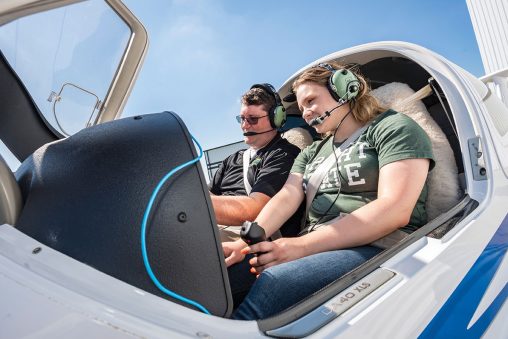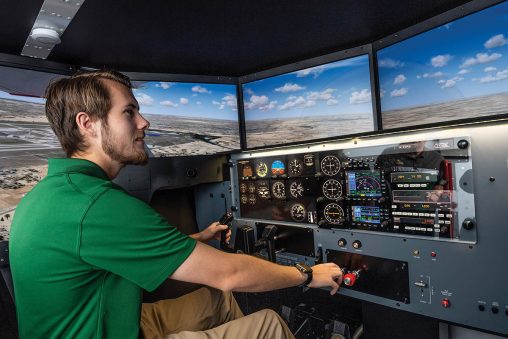
The potential of students in Wright State University’s aviation science and technology program is limitless. (Photos Erin Pence)
“The sky is not the limit. It’s just the beginning.” – Chuck Yeager, the late decorated Air Force pilot who was the first to fly faster than sound.
The same can be said about Wright State University’s aviation science and technology program, beginning its second year of educating students to become pilots whose potential is limitless. The goals are to meet the growing need for pilots, raise the university’s level of awareness, and fulfill the dreams of young people who yearn to fly. And, like powered flight, the program began with the Wright brothers.
Beth Hersman, Ph.D., chair of the School of Aviation, proudly points to the most visible and logical connection between the university and the new program. “We’re Wright State. We’re named after the Wright brothers,” Hersman said.
The university previously had a class for private pilots in the Department of Kinesiology and Health, of which Hersman is professor and department chair. But the current and looming need for pilots to replace those who are to retire spurred Wright State into spreading its wings in aviation education. As noted on the program’s website: “The aviation industry is experiencing a shortage of qualified pilots in the United States. There could be a shortage of as many as 130,000 pilots over the next two decades.”
When talking about piloting, commercial airlines come to mind, but the program recognizes there also are careers in corporate or charter operations, cargo airlines, survey piloting, governmental contracting, flight instruction, law enforcement, and Federal Aviation Administration inspection.

Savannah Oakley is a pioneer of the aviation program, enrolling at Wright State as an undecided major before the program’s official launch.
The School of Aviation welcomed its first class in August 2024, making available a Bachelor of Science in Aviation Science and Technology, an Associate of Applied Science in Aviation Science and Technology, or a minor in aviation studies. The university partners with First Flight Aviation, a flight school at Dayton-Wright Brothers Airport in Miamisburg, for classroom and flight instruction. Some classes take place at Millett Hall, home of the College of Health, Education, and Human Services.
Enrollment is small compared to other disciplines—the inaugural class was composed of about 15 students. The goal is to eventually graduate 40 students each year, Hersman said. “It’s a demanding program,” Hersman added. “It’s not something where you can skip studying. If you don’t come prepared for flight lab, you don’t fly. And if you don’t fly, you get behind.”
Working toward increasing that enrollment is Eli Justice, admissions recruiter in the Office of Undergraduate Admissions. Justice said he’s been approached by potential students at college fairs, and the word about Wright State is spreading. For the Fall 2025 Semester, he said, applications have arrived from students representing 21 states, primarily Ohio, Indiana, Kentucky, and Michigan. Despite being geographically diverse, the applicants have one thing in common: a love of flying.
“There’s a passion. It’s like a dream,” said Craig Castle, instructor and assistant chief flight instructor, of the students in the program who’ve wanted to fly since childhood. “This reminds them of what they always wanted to do with their life. It’s attainable.”
Savannah Oakley is one such student. “I fell in love with flying when I was 10 years old,” said the Kettering resident. “I love every aspect. Being able to fly is a free feeling. It’s not every day that anyone gets to fly in the sky – it’s a happy place for me.”
Oakley is a pioneer of the aviation program, enrolling at Wright State as an undecided major prior to its official start.
“I heard about the program. I knew it was in the works. I grew up at the airport they partner with; my uncle flies out of that airport.” Oakley added, “They are building a super strong program. It’s going to go far. I’ve flown with really awesome people, and been taught by really awesome people who really know what they’re talking about.”

Wright State partners with First Flight Aviation, a flight school at Dayton-Wright Brothers Airport in Miamisburg, for classroom and flight instruction.
The chief flight instructor is Mick Phillips, who has brought a certain pedigree and philosophy to the program. He was a flight instructor at the Air Force Academy in Colorado, and aims to develop Wright State “into an elite, top-end flight school.” After all, he said, “we’re named after the Wright brothers, and their airplane is in our logo. We want to be mentioned in the same conversation as other elite schools.”
Phillips continued, “What that entails is we have to teach differently, and be sure the instructors and the students understand that if we’re going to be at that level, they must want to be part of that culture, and be not just a good aviator, but the best on the planet, the best in the industry.”
Phillips likens the culture he’s instilling to that of a championship collegiate sports team. At Ohio State, he said for example, he said, “they’re looking for national championships. We want elite pilots. We encourage that and facilitate that every day. You have to dedicate time outside of the classroom to study. If you want to go party, this is not the program for you.”
He added, “We want the program to be viewed as highly competitive. From day one, you’re competing for a flight spot,” much the same as competing for a starting spot on the Ohio State football team, he said. “You have to earn that spot. That competitiveness really drives an elite status.”
“I’m a big advocate of team building,” Phillips continued. Along that line, each class, which enrolls by semester, develops its own patch to wear on their flight jackets. That way, each class is identifiable throughout its four years, and it adds a pride factor.
Those who excel in their aviation/academic progress can become instructors within the program. “We can hire out our best and brightest pilots to be instructors at the beginning of their third year,” Hersman said.
Aviation is starting its second full academic year, so this instructor arrangement is yet to come. But when it does, it’ll help defray the cost of tuition and flight lab fees for the student aviators.
Hersman said the program is striving to develop partnerships that would help defray the costs for students.

Mick Phillips, right, chief flight instructor, was a flight instructor at the Air Force Academy in Colorado before joining First Flight Aviation.
Castle added that alumni can help support the program “not just financial on the front end, but the back end to make job connections. Anything that can open a door for our students. We’re just so new, we welcome anyone who wants to help.”
What sets Wright State apart from other Ohio universities that offer aviation instruction, Hersman said, is the academic degree attached to the pilot credentials.
As part of her academics, Oakley said she takes mathematics, English, science, “core classes, pretty much like every other Wright State student has to take, and a couple electives. Mainly my class schedule is a lot of ground classes for flying.”
Oakley said she has her private pilot’s license and is working toward earning an instrument rating. Other ratings are upcoming. She expects to graduate in 2027 or 2028. “It’s a five-year route. Some ratings take a little longer than others.”
She hopes eventually to be one of the flight instructors in the program for which she sees nothing but blue skies. The program “is going to continue to thrive and produce really good, safe pilots,” she said.
As Yeager said, the sky is not the limit, but the beginning. Wright State heeds those words.
This article was originally published in the 2025 issue of the Wright State Magazine. Read more stories at wright.edu/magazine.

 Milling around
Milling around  Wright State recognizes Nursing Professor Kim Ringo for advancing international student success
Wright State recognizes Nursing Professor Kim Ringo for advancing international student success  Wright State honors graduating students for distinguished doctoral dissertations
Wright State honors graduating students for distinguished doctoral dissertations  Top 10 Newsroom videos of 2025
Top 10 Newsroom videos of 2025  Museum-quality replica of historic Hawthorn Hill donated to Wright State
Museum-quality replica of historic Hawthorn Hill donated to Wright State 